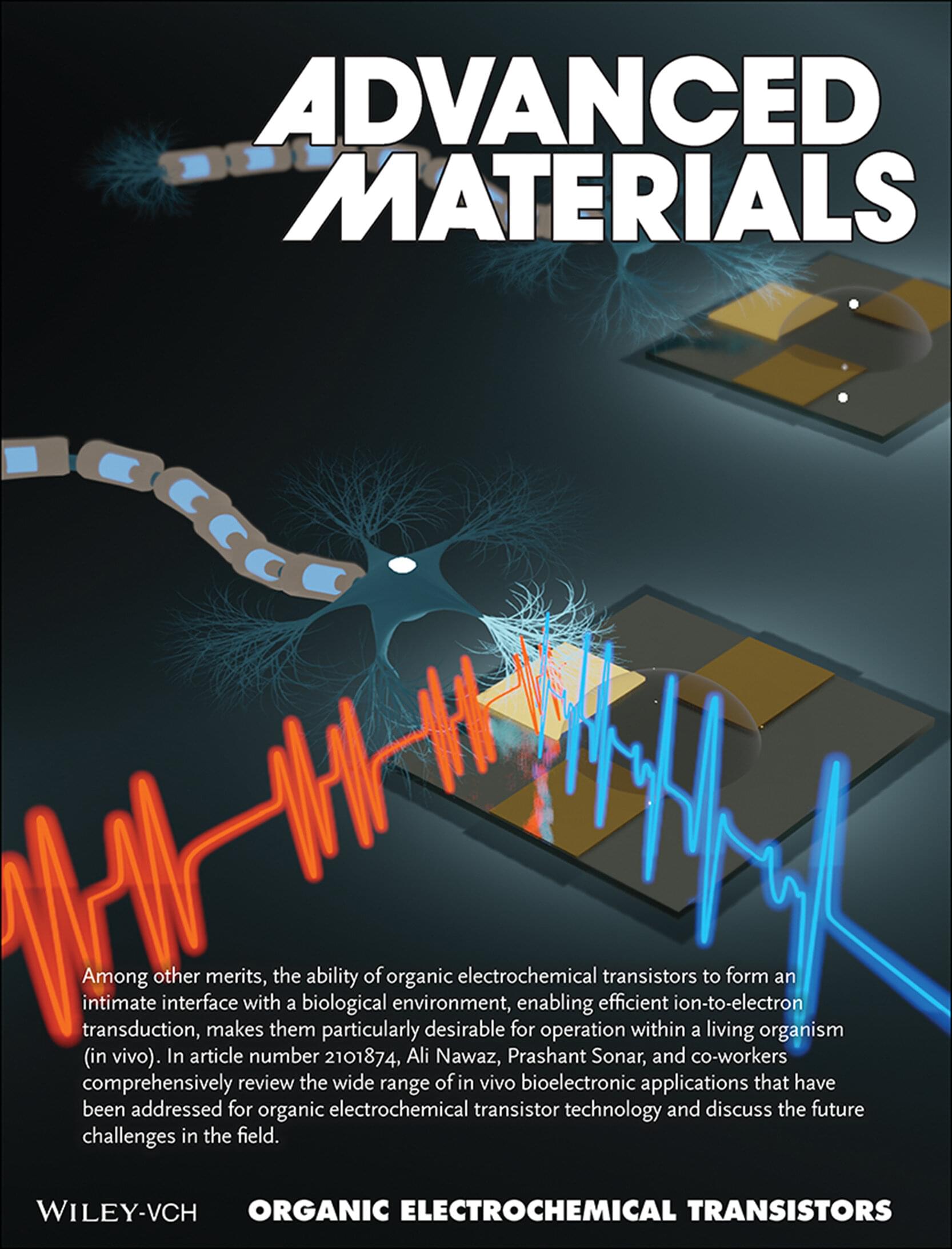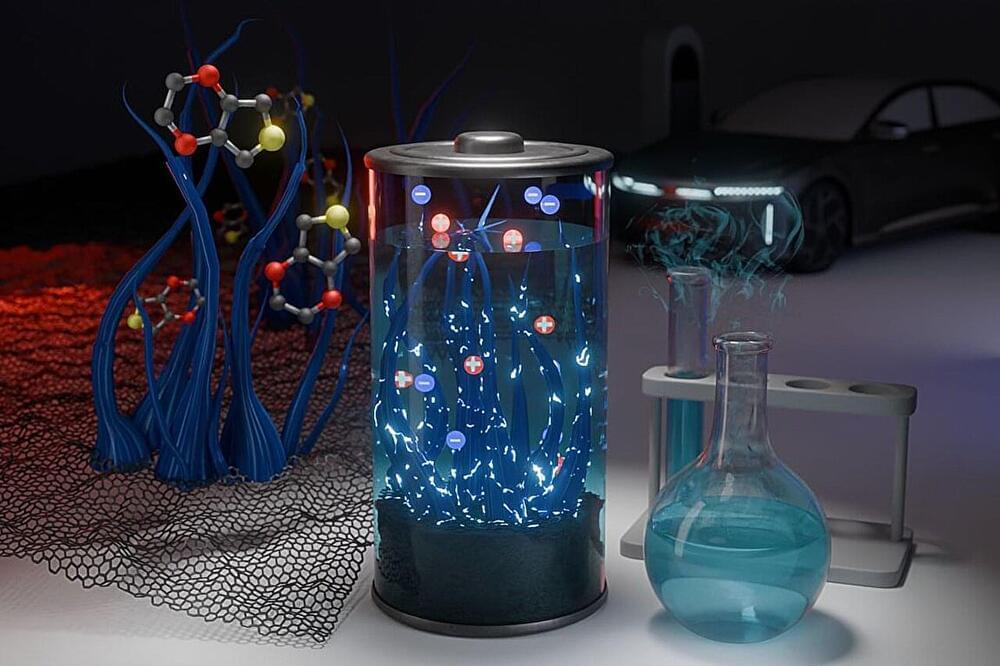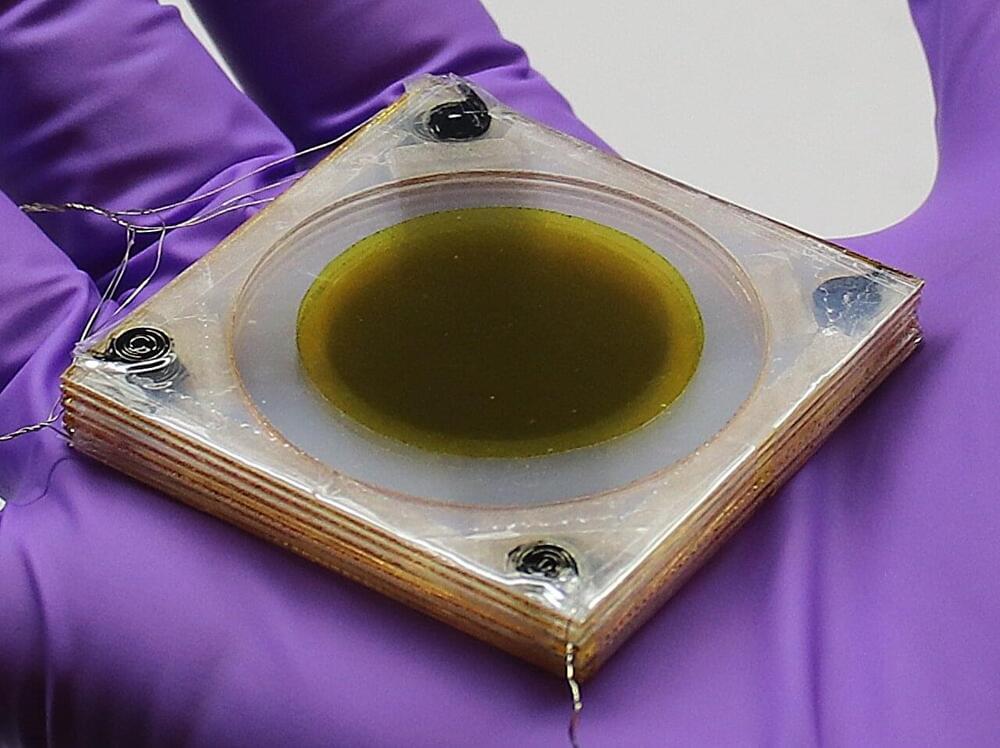Caltech just manufactured a wearable sweat sensor that “inkjet prints” biomarkers to better monitor the human body.
Category: wearables – Page 13

Focus on organic transistors for health sensors within living organisms
QUT researchers are part of an international group who have explored ways in which organic transistors are being developed for use as wearable health sensors.
The currently available bioelectronic devices, such as pacemakers, that can be embedded with the human body are mostly based on rigid components.
However, the next-generation devices—which are researched and developed by bioelectronic engineers, organic chemists, and materials scientists—will use soft organic materials that allow comfortable wearability as well as efficient monitoring of health.


Plastic supercapacitors could solve energy storage problems
Microscale light-emitting diodes (micro-LEDs) are emerging as a next-generation display technology for optical communications, augmented and virtual reality, and wearable devices. Metal-halide perovskites show great potential for efficient light emission, long-range carrier transport, and scalable manufacturing, making them potentially ideal candidates for bright LED displays.
However, manufacturing thin-film perovskites suitable for micro-LED displays faces serious challenges. For example, thin-film perovskites may exhibit inhomogeneous light emission, and their surfaces may be unstable when subjected to lithography. For these reasons, solutions are needed to make thin-film perovskites compatible with micro-LED devices.
Recently, a team of Chinese researchers led by Professor Wu Yuchen at the Technical Institute of Physics and Chemistry of the Chinese Academy of Sciences has made significant strides in overcoming these challenges. The team has developed a novel method for the remote epitaxial growth of continuous crystalline perovskite thin films. This advance allows for seamless integration into ultrahigh-resolution micro-LEDs with pixels less than 5 μm.

Next-generation wearables: Compact cooling pump drops temperatures by 16°F
UCLA materials scientists have developed a compact cooling technology that can pump away heat continuously using layers of flexing thin films. The design is based on the electrocaloric effect, in which an electric field causes a temporary change in a material’s temperature.
In lab experiments, the researchers found that the prototype could lower ambient temperatures of its immediate surroundings by 16 degrees Fahrenheit continuously and up to 25 degrees at the source of the heat after about 30 seconds.
Detailed in a paper published in the journal Science, the approach could be incorporated into wearable cooling technology or portable cooling devices.

Brain-inspired nanotech offers new path for smarter electronics
Imagine a future where your phone, computer or even a tiny wearable device can think and learn like the human brain—processing information faster, smarter and using less energy.
A new approach developed at Flinders University and UNSW Sydney brings this vision closer to reality by electrically “twisting” a single nanoscale ferroelectric domain wall.
The domain walls are almost invisible, extremely tiny (1–10 nm) boundaries that naturally arise or can even be injected or erased inside special insulating crystals called ferroelectrics. The domain walls inside these crystals separate regions with different bound charge orientations.
AI agents: The scientist’s new superpower | Stefan Harrer | TEDxSydney Salon
Might Artificial Intelligence be the ideal lab assistant? Stefan Harrer delves into the revolutionary role of generative AI in science. He reveals how AI agents are not just tools but transformative partners for scientists enabling them to achieve breakthroughs in biology and beyond, heralding a new era of scientific discovery and innovation. This inspiring talk highlights the potential for AI to redefine the boundaries of the scientific method and our understanding of life. Dr Stefan Harrer is the Director of AI for Science at CSIRO, Australia’s national science agency. He is on a mission to revolutionise scientific discovery by harnessing the power of AI agents. In senior leadership roles at IBM Research, he led groundbreaking work on AI-driven epilepsy management and developed the world’s first AI-powered wearable for seizure prediction. An inventor with 73 granted patents, a passionate advocate for ethical AI, and a mentor and advisor to startups and governments, Stefan inspires the next frontier of AI innovation and use. This talk was given at a TEDx event using the TED conference format but independently organized by a local community.
NVIDIA’s Jetson Thor, Robotics, and Smart Wearables
Discover new technologies shaping 2025! NVIDIA’s Jetson Thor system is set to revolutionize humanoid robotics, while Meta’s Ray-Ban Stories smart glasses lead the wearable tech trend with over 1 million units sold. AI continues to transform industries with tools like ChatGPT. Don’t miss Unitree’s B2-W robot showcasing incredible stunts, speed, and heavy payload capabilities—available for purchase now!
📲 Follow us on social media @toborlife for updates, innovations, and exciting announcements!
💬 Have questions? Contact us at:
📧 [email protected].
📞 (408) 409‑4061
#RobotDogs #Humanoids #AIInnovation #FutureIsHere #TOBoRLife #robotdog #securitydog.
Don’t forget to like, comment, and subscribe for more amazing content from TOBoRLife! 🤖✨

Breakthrough in Zinc-based Rechargeable Batteries: A safer, sustainable alternative
Case Western Reserve University researcher advances zinc-sulfur battery technology. Rechargeable lithium-ion batteries power everything from electric vehicles to wearable devices. But new research from Case Western Reserve University suggests that a more sustainable and cost-effective alternative may lie in zinc-based batteries.
In a study published recently in Angewandte Chemie, researchers announced a significant step toward creating high-performance, low-cost zinc-sulfur batteries.
“This research marks a major step forward in the development of safer and more sustainable energy storage solutions,” said Chase Cao, a principal investigator and assistant professor of mechanical and aerospace engineering at Case School of Engineering. “Aqueous zinc-sulfur batteries offer the potential to power a wide range of applications — from renewable energy systems to portable electronics — with reduced environmental impact and reliance on scarce materials.”

Meta appoints UFC’s president to its board
Meta has appointed three new members to its board of directors, the company announced Monday: UFC president and CEO Dana White, European investment company Exor CEO John Elkann, and tech investor and entrepreneur Charlie Songhurst.
In a press release, Meta CEO Mark Zuckerberg said that White, Elkann, and Songhurst “will add a depth of expertise and perspective” that’ll help Meta “tackle the massive opportunities ahead with AI, wearables, and the future of human connection.”
White was named CEO of UFC in 2023, after the organization merged with WWE to form a new public company, TKO Group Holdings. He’s responsible for the overall strategic direction of UFC’s global business, including its live events series.